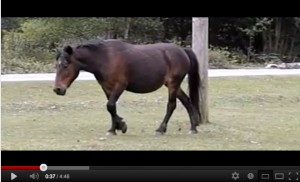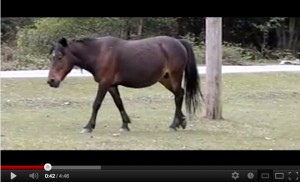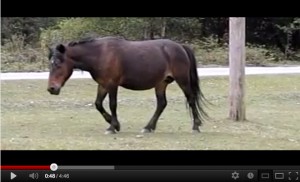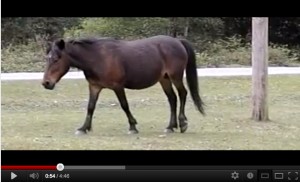Learning How Horses Walk
Sometimes the best way to understand how your horse moves is to mindfully experience how your own body moves. This is called experiential learning. When I used to teach comparative anatomy and functional anatomy in the university, I always told my students that the number one tool we all have to understand how animals move is our own bodies. See if you don’t discover something really cool about horse movement by trying this exercise in experiential learning.
What you need to do is read the next four paragraphs (down to the break in the text), and then set your computer aside and get down on the floor on your hands and knees. Yes, really. Don’t just think about it, and don’t ask someone else (like your teenager) to do it so you can watch them. You need to experience this for it to have the substantial learning impact it can have.
Get on your hands and knees, supporting yourself. In other words, you don’t want to crawl like you’re scooting under barbed wire. War games are next week. (OK, not really. But don’t scoot.) Then just crawl across the floor as far as you can without hitting the furniture. Don’t think about it; just do it.
Once you’ve done that, and have your rhythm established, turn around and go back the other way, still crawling, but this time just pay attention to — but do not try to control — the order in which your hands and knees hit the floor. I suggest you choose your left knee to start with as you make mental notes, and that you then notice what hits the floor next after your left knee, then next after that, and so on. Do it several times so that you have a good idea of the pattern that exists when you crawl. You can even stop and jot that pattern down.
Now go crawl. :-) I will skip some lines here so you can’t easily see what I write next, and can instead scroll down to it after you do the crawling exercise.
Unless something really interesting has happened (and bodies are interesting things, that surprise us sometimes), your order of motion was left knee, then left hand, then right knee, then right hand. Of course, if you started by paying attention to the right hand coming down first, then the sequence would be right hand, left knee, left hand, right knee, right hand, and so on. But the sequence is still identical. It is that you put down the back “leg” (knee) on one side, and this is followed by putting down the front “leg” (hand) of that same side, and then you put down the back leg of the other side, which is then followed by the front leg of that other side.
Note: It is very important to realize that the sequence is always the same, but that it will at first look different if you “start” with a different foot. Each time a front foot comes down and hits the ground, the next foot that comes forward will be the hind foot of the opposite side. But this is then followed by the forefoot on the same side.
Here’s what it looks like in a walking horse, in slow motion. These images are stills edited from a video by British videographer “Mike Snail”, who posts his work series at Youtube under “Slow Motion Connection.” I left in the time stamp information so you can see the sequence of things.
Starting with the left hind foot touching the ground…
Then the left front foot touches the ground…
Then the right hind comes forward and strikes the ground…
And finally the right front foot strikes the ground.
The entire clip is at youtube, here. I strongly urge you to watch it, paying close attention to the sequence in which the feet strike the ground.
Now of course the point of all this is to go back and compare the horse’s sequence of limb movements at the walk to your own sequence of limb movements at a crawl. They are identical: left rear to left fore to right rear to right fore. And they are identical to crawling in a human baby as well. It is thought that this similarity is due to neurological homology — that the firing mechanisms that activate the limb muscles in that particular pattern are literally the same in both horses and humans. In fact, Susan Patrick and two other researchers published a paper in the Journal of Neurophysiology in 2008 suggesting the structural/ functional pattern of the nerves that activate crawling and walking is so conservative that it’s the same in almost all quadrupeds — which is to say, in every animal with four legs. (Note: In biology, “conservative” means it has not changed evolutionarily. It has remained the same over vast spans of time during which other structures have evolved and changed. For more discussion of homology in gaits, see the previous blog post.)
What does this mean for you, as a horseperson who wants a better experience with your horse? It means you have an inborn mechanism that allows you to understand where your horse’s feet are. You have probably been told by at least one trainer, on a DVD if nothing else, how important it is to know where your horse’s feet are as it moves. (That’s because it’s only really possible to move a foot with rein or seat if that foot is off the ground at the time, not supporting the horse’s weight. You can’t move a foot someone is standing on.) And if so, you’ve probably also been told one or more complicated ways to learn how to tell where your horse’s feet are. But, as long as you’re willing to use your experiential knowledge, you’ve got all the tools you need right inside your own body.
Here’s a suggestion: crawl around some more. Get a good “feel” for your own body. (Yes, I am suggesting that good “feel” for your horse begins with good “feel” of yourself.) Then go out to your horse and ask someone to hold its lead line for you, and just halter it. Then do one of two things: (1) get on your horse with its normal saddle, but place your hands on the withers right in front of the saddle, as far down the slope as you can in that position, or (better yet!) (2) get up on your horse bareback and lay your hands on the withers on each side, on the sloping area. Remember that if a friend is holding your horse’s lead line, you don’t need to worry about holding the reins. Then close your eyes and pause, for a moment, to remember — as viscerally as you can — how it felt to crawl. Fix that in your mind. You can even let your legs and arms twitch a little bit as you remember their motion.
Then have your friend slowly lead your horse forward at a walk.
What you want to do here is focus on the similarity between the four feet your horse is moving and the pattern of your own limb motion when you crawled. If you can let those two “walking feelings” overlap in your mind and in your body-awareness, you will suddenly have very strong “feel” for your horse’s feet. And although at first you will be focused on when each foot hits the ground, the awareness will grow to the point that if you just turn your mind a little bit, you will know when each foot comes up off the ground to swing forward.
If it helps, particularly if you are on your horse bareback, you can lean forward so that you are oriented with your back more parallel to your horse’s back when you do this, which will overlap your fore and hind limbs more completely with your horse’s fore and hind limbs.
Either way, with a saddle or without, this exercise allows you to use your own body’s proprioceptive senses to feel your horse. Your horse, in other words, becomes an extension of your own body.
And how cool is that?
Many thanks to my business partner Jo Belasco for the work she’s done with bareback riders who have their eyes closed as they learn to feel a horse’s feet at a walk.
Dawn Adams, Ph.D.
Copyright 2012 Dawn Adams, Ph.D. Do not reproduce in any format without written permission from Dr. Adams.
The Rider Marketplace
International Horse News
© 2025 Created by Barnmice Admin.
Powered by
![]()
-
Quick Links
- Horse Blogs
- Horse Forums
- Horse Videos
- Horse Photos
-
Sister Sites
- The Rider Marketplace
- The Rider
- Equine Niagara News
-
Helpful Links
- Advertise With Us
- Barnmice Tour
- Feedback
- Report an Issue
- Terms of Service
© Barnmice | Design by N. Salo



